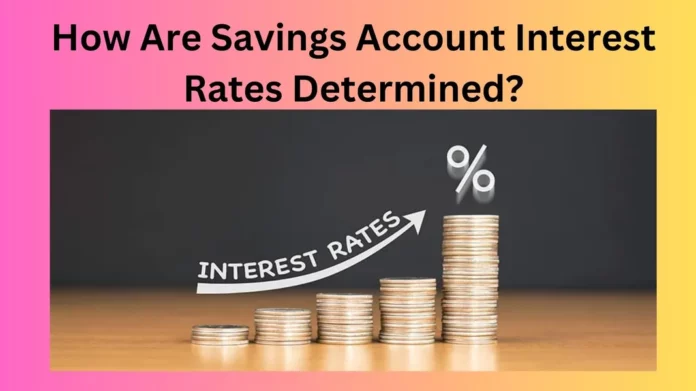In the financial realm, where every penny counts, understanding how savings account interest rates are determined is paramount for savvy investors and diligent savers alike. Your savings account is not just a secure repository for your funds; it’s an opportunity to earn additional money through interest.
In this article, we’ll embark on a journey to unravel the intricacies of savings account interest rates, exploring the factors that influence them and how they impact your financial well-being.
1. The Basics of Savings Account Interest Rates
Before diving into the nitty-gritty details, let’s establish a solid foundation. Savings account interest rates represent the percentage of your account balance that the bank pays you in return for keeping your money with them. It’s essentially the reward for being a diligent saver.
2. Supply and Demand Dynamics
One of the primary determinants of savings account interest rates is the classic economic interplay of supply and demand. When the demand for loans is high, banks often need more deposits to lend out. This increased demand for deposits can lead to higher interest rates on savings accounts.
3. Central Bank Influence
The central bank, often a nation’s reserve bank, plays a pivotal role in shaping interest rates. By adjusting the benchmark interest rate, the central bank indirectly influences the rates offered by commercial banks. A higher benchmark rate usually translates to higher savings account interest rates.
4. Economic Conditions
The overall economic landscape is a significant factor in determining interest rates. During periods of economic growth, banks may offer higher interest rates to attract more deposits. Conversely, in economic downturns, rates might be lower to stimulate spending and borrowing.
5. Inflation’s Sneaky Impact
Inflation quietly erodes the purchasing power of your money. To combat this, banks aim to set interest rates that outpace inflation, ensuring that your savings don’t lose value over time. Understanding the inflation factor is crucial when assessing the real value of your interest earnings.
6. Bank Policies and Strategies
Each bank operates within its unique set of policies and strategies. Some banks may prioritize attracting more deposits, offering competitive interest rates, while others may focus on lending and keep savings rates lower. Understanding your bank’s approach can help you make informed decisions.
7. Your Relationship with the Bank
Believe it or not, your relationship with the bank matters. Many banks offer loyalty bonuses or higher interest rates for long-standing customers. Building a rapport with your bank might just earn you a better deal on your savings.
8. Competition Among Banks
Competition is a driving force in the financial sector. When banks vie for customers, they may offer higher interest rates to entice individuals to choose their services. Keeping an eye on the market and being willing to switch banks for a better deal can work to your advantage.
9. Government Regulations
Governments often regulate the financial industry to ensure stability and protect consumers. These regulations can influence interest rates directly or indirectly. Understanding the regulatory landscape can give you insights into the stability and reliability of your savings account.
10. Time and Type of Account
The duration for which you commit your funds and the type of savings account you choose also impact the interest rates. Longer-term deposits or specialty savings accounts might offer higher rates, but they often come with certain restrictions.
11. External Economic Events
Global events, such as economic crises or geopolitical shifts, can have ripple effects on interest rates. These external factors may prompt banks to adjust rates to navigate the evolving economic landscape.
12. Technological Advancements
In the digital age, technological advancements play a role in shaping the financial sector. Online banks, with lower overhead costs, may offer more competitive interest rates compared to traditional brick-and-mortar institutions.
13. Transparency and Communication
Understanding the fine print is crucial when it comes to savings account interest rates. Banks that prioritize transparency and effective communication about rate changes empower customers to make informed decisions.
14. Financial Education
Being financially literate puts you in the driver’s seat. Educate yourself about how savings account interest rates work, enabling you to make strategic decisions aligned with your financial goals.
15. Conclusion
In conclusion, savings account interest rates are a multifaceted entity influenced by a myriad of factors. From economic conditions to your relationship with the bank, each element plays a role in shaping the interest rates offered. As a prudent saver, being aware of these determinants empowers you to make informed decisions that align with your financial aspirations.
FAQs
1. Q: Can I negotiate a higher interest rate with my bank?
A: While negotiating interest rates may not be common, it’s worth reaching out to your bank and expressing your loyalty. Some banks may offer personalized deals to valued customers.
2. Q: How often do savings account interest rates change?
A: Interest rates can change based on various factors, and the frequency of changes depends on the bank’s policies, economic conditions, and regulatory influences.
3. Q: Do online banks offer better interest rates than traditional banks?
A: In many cases, online banks have lower operating costs, allowing them to offer more competitive interest rates. However, it’s essential to consider other factors like services and convenience.
4. Q: Are there any risks associated with high-interest savings accounts?
A: Generally, savings accounts are considered low-risk. However, factors like inflation and economic downturns can impact the real value of your savings over time.
5. Q: How can I stay informed about changes in savings account interest rates?
A: Regularly check your bank’s communications, follow financial news, and consider subscribing to newsletters or alerts that provide updates on interest rates and economic trends.
In navigating the landscape of savings account interest rates, staying informed and being proactive are key. By understanding the determinants and asking the right questions, you can optimize your savings strategy and make the most of your financial journey.















